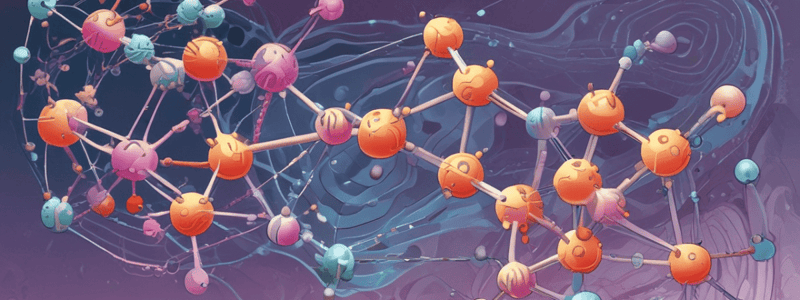Podcast
Questions and Answers
What is the primary function of enzymes in the body?
What is the primary function of enzymes in the body?
- To catalyze the breakdown of peptides
- To synthesize ATP
- To regulate the rate of metabolic pathways (correct)
- To activate protein phosphatases
What type of modification affects the activity of an enzyme?
What type of modification affects the activity of an enzyme?
- Allosteric modification
- Covalent modification (correct)
- Hydrolysis
- Denaturation
What is the effect of ATP buildup on PFK1 enzyme activity?
What is the effect of ATP buildup on PFK1 enzyme activity?
- It increases the substrate concentration
- It activates PFK1
- It inhibits PFK1 (correct)
- It has no effect on PFK1
What is the role of allosteric activators in enzyme regulation?
What is the role of allosteric activators in enzyme regulation?
What is the result of ADP binding to the allosteric site of PFK1?
What is the result of ADP binding to the allosteric site of PFK1?
Which of the following is NOT a characteristic of the R state of an enzyme?
Which of the following is NOT a characteristic of the R state of an enzyme?
What is the effect of AMP on PFK1 enzyme activity?
What is the effect of AMP on PFK1 enzyme activity?
What is the purpose of allosteric regulation in enzyme activity?
What is the purpose of allosteric regulation in enzyme activity?
What is the primary function of a protein phosphatase in the context of phosphorylation?
What is the primary function of a protein phosphatase in the context of phosphorylation?
What is the term for the process by which an inactive enzyme, or zymogen, becomes active?
What is the term for the process by which an inactive enzyme, or zymogen, becomes active?
What type of post-translational modification adds a phosphate group to a protein?
What type of post-translational modification adds a phosphate group to a protein?
What is the effect of phosphorylation on the activity of an enzyme?
What is the effect of phosphorylation on the activity of an enzyme?
What is the purpose of making enzymes in an inactive form, known as zymogens?
What is the purpose of making enzymes in an inactive form, known as zymogens?
What type of bond can a phosphoryl group make?
What type of bond can a phosphoryl group make?
What is the net effect of phosphorylation on the charge of a protein?
What is the net effect of phosphorylation on the charge of a protein?
What is the molecule that provides the phosphate group for phosphorylation?
What is the molecule that provides the phosphate group for phosphorylation?
What is the function of JAK kinases in JAK-STAT receptors?
What is the function of JAK kinases in JAK-STAT receptors?
What is the consequence of misfolded proteins?
What is the consequence of misfolded proteins?
What is the function of chaperone proteins?
What is the function of chaperone proteins?
What is the result of cytokine binding to JAK-STAT receptors?
What is the result of cytokine binding to JAK-STAT receptors?
What is the function of serine-threonine kinase receptors?
What is the function of serine-threonine kinase receptors?
What is the role of protein kinases in signal transduction?
What is the role of protein kinases in signal transduction?
What is the function of hormone proteins?
What is the function of hormone proteins?
What is the result of protein misfolding and aggregation?
What is the result of protein misfolding and aggregation?
Flashcards are hidden until you start studying
Study Notes
Covalent Modification
- Phosphorylation, glycosylation, methylation, and acetylation are the most common forms of covalent modification.
- Glycosylation is a post-translational modification.
- Phosphorylation occurs when a protein kinase transfers a phosphate from ATP to the hydroxyl group of a specific serine, threonine, or tyrosine amino acid on the target enzyme, causing a conformational change that makes certain enzymes more or less active.
- Dephosphorylation occurs when a protein phosphatase removes the phosphate by hydrolysis, reversing the effect of phosphorylation.
- Phosphorylation adds two negative charges and can make H-bonds.
Zymogens and Proteolytic Cleavage
- Zymogens are inactive enzymes that become active through proteolytic cleavage.
- Proteolytic cleavage is an irreversible process that activates enzymes.
- This process helps prevent enzymes from prematurely breaking down other proteins during their production or release.
Enzymes
- Enzymes are catalysts that speed up the rate of reaction by lowering activation energy.
- Enzymes regulate the rate of metabolic pathways in the body.
- Allosteric regulation involves conformational changes that affect the catalytic site, and is achieved through allosteric activators or inhibitors binding to the active catalytic site.
Allosteric Regulation
- Allosteric regulation can occur in two states: T (tense) with low affinity and R (relaxed) with high affinity.
- Adenosine diphosphate (ADP) or adenosine monophosphate (AMP) are allosteric activators of PFK1, which is activated when ATP concentration in a muscle cell decreases.
- ATP build-up inhibits PFK1.
Enzyme Regulation
- Enzyme activity can be regulated by covalent modification, such as phosphorylation of an amino acid from the kinase domain.
- Signal transduction occurs from the membrane to the signal transducer protein through covalent modification.
JAK-STAT Receptors
- JAK-STAT receptors are heterodimers, consisting of two different proteins that bind together.
- They are activated when a cytokine attaches, and JAK kinases bind to the heterodimers and phosphorylate each protein.
- Signal transduction occurs from the membrane to the signal transducer protein.
Serine-Threonine Kinase Receptors
- Cytokine dimer binds to heterodimers, and one heterodimer protein phosphorylates another, which then phosphorylates a signal transducer protein.
Protein Functions
- Hormonal proteins coordinate an organism's activities, with examples including insulin.
- Contractile and motor proteins facilitate movement, with examples including actin and myosin proteins.
- Structural proteins provide structure and support, with three types of structural proteins.
Misfolding and Chaperone Proteins
- Misfolded proteins can clump together, potentially harming cells.
- Chaperone proteins aid in correct folding by providing the right environment for proper folding.
- Misfolding can create amyloid fibrils, leading to diseases like Alzheimer's and Parkinson's.
Studying That Suits You
Use AI to generate personalized quizzes and flashcards to suit your learning preferences.



